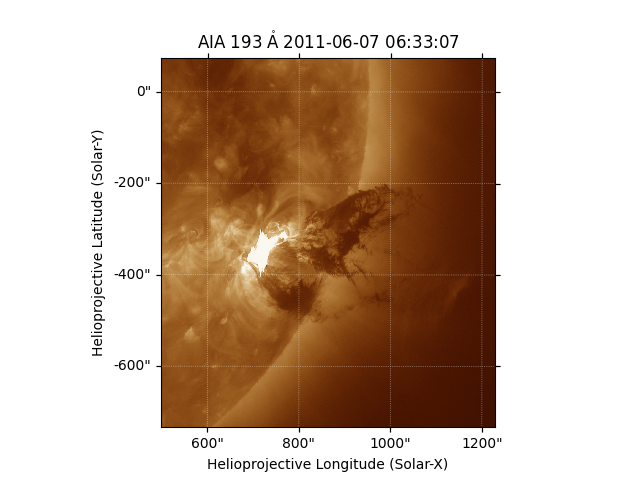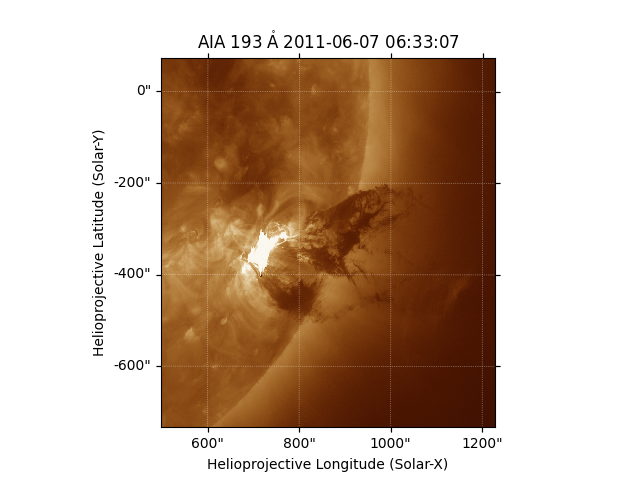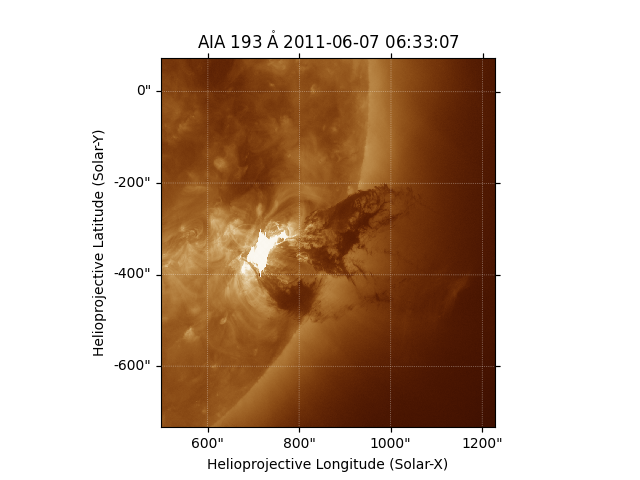Note
Go to the end to download the full example code
Compensating for Solar Rotation#
Often a set of solar image data consists of fixing the pointing of a field of view for some time and observing. Features on the Sun will differentially rotate depending on latitude, with features at the equator moving faster than features at the poles.
In this example, the process of shifting images in a MapSequence
to account for the differential rotation of the Sun is demonstrated using the
mapsequence_coalign_by_rotation() function.
import matplotlib.pyplot as plt
import sunpy.data.sample
from sunpy.map import Map
from sunkit_image import coalignment
First, create a MapSequence with sample data.
mc = Map(
[
sunpy.data.sample.AIA_193_CUTOUT01_IMAGE,
sunpy.data.sample.AIA_193_CUTOUT02_IMAGE,
sunpy.data.sample.AIA_193_CUTOUT03_IMAGE,
sunpy.data.sample.AIA_193_CUTOUT04_IMAGE,
sunpy.data.sample.AIA_193_CUTOUT05_IMAGE,
],
sequence=True,
)
Files Downloaded: 0%| | 0/1 [00:00<?, ?file/s]
AIA20110607_063307_0193_cutout.fits: 0%| | 0.00/1.45M [00:00<?, ?B/s]
Files Downloaded: 100%|██████████| 1/1 [00:00<00:00, 2.75file/s]
Files Downloaded: 100%|██████████| 1/1 [00:00<00:00, 2.74file/s]
Files Downloaded: 0%| | 0/1 [00:00<?, ?file/s]
AIA20110607_063931_0193_cutout.fits: 0%| | 0.00/1.45M [00:00<?, ?B/s]
AIA20110607_063931_0193_cutout.fits: 80%|████████ | 1.16M/1.45M [00:00<00:00, 8.71MB/s]
Files Downloaded: 100%|██████████| 1/1 [00:00<00:00, 2.47file/s]
Files Downloaded: 100%|██████████| 1/1 [00:00<00:00, 2.46file/s]
Files Downloaded: 0%| | 0/1 [00:00<?, ?file/s]
AIA20110607_064555_0193_cutout.fits: 0%| | 0.00/1.45M [00:00<?, ?B/s]
Files Downloaded: 100%|██████████| 1/1 [00:00<00:00, 2.56file/s]
Files Downloaded: 100%|██████████| 1/1 [00:00<00:00, 2.56file/s]
Files Downloaded: 0%| | 0/1 [00:00<?, ?file/s]
AIA20110607_065219_0193_cutout.fits: 0%| | 0.00/1.46M [00:00<?, ?B/s]
Files Downloaded: 100%|██████████| 1/1 [00:00<00:00, 1.52file/s]
Files Downloaded: 100%|██████████| 1/1 [00:00<00:00, 1.52file/s]
Files Downloaded: 0%| | 0/1 [00:00<?, ?file/s]
AIA20110607_065843_0193_cutout.fits: 0%| | 0.00/1.45M [00:00<?, ?B/s]
AIA20110607_065843_0193_cutout.fits: 80%|████████ | 1.16M/1.45M [00:00<00:00, 7.83MB/s]
Files Downloaded: 100%|██████████| 1/1 [00:00<00:00, 1.95file/s]
Files Downloaded: 100%|██████████| 1/1 [00:00<00:00, 1.95file/s]
Let’s plot the MapSequence so we can later compare it with the shifted result.
plt.figure()
anim = mc.plot()

The mapsequence_coalign_by_rotation()
function can be applied to the Map Sequence
derotated = coalignment.mapsequence_coalign_by_rotation(mc)
By default, the de-rotation shifts are calculated relative to the first map
in the MapSequence.
This function does not differentially rotate the image (see
Differentially rotating a map
for an example). It is useful for de-rotating images when the effects of
differential rotation in the MapSequence can be ignored.
See the docstring of
mapsequence_coalign_by_rotation()
for more features of the function.
To check that the applied shifts were reasonable, plot an animation of the shifted MapSequence to compare with the original plot above.
plt.figure()
anim_derotate = derotated.plot()

The de-rotation shifts used in the above function can be calculated without
applying them using the
calculate_solar_rotate_shift() function.
shifts = coalignment.calculate_solar_rotate_shift(mc)
The calculated shifts can be passed as an argument to
mapsequence_coalign_by_rotation().
derotate_shifts = coalignment.mapsequence_coalign_by_match_template(mc, shift=shifts)
plt.figure()
anim_derotate_shifts = derotate_shifts.plot()
plt.show()

Total running time of the script: (0 minutes 5.656 seconds)